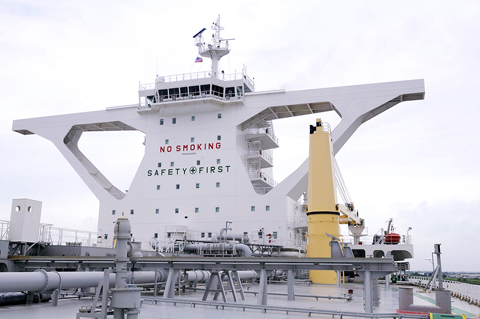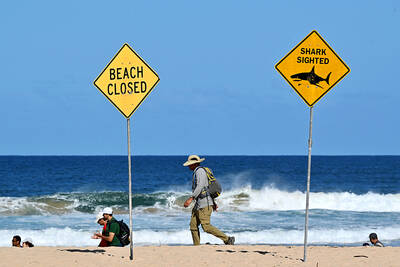A Taiwanese supertanker skimmed oil from the Gulf of Mexico yesterday as the months-long disaster became the worst accidental spill on record.
Rough seas and strong winds continued to delay clean-up efforts, displace protective booms and push the oil deeper into fragile coastal wetlands, endangering wildlife preserves and the thousands of birds nesting there.
“This is going to be a very long and arduous clean-up operation in the days to come,” US Coast Guard Admiral Paul Zukunft said. “I’m especially concerned with some of the wildlife habitats.”

PHOTO: EPA
An estimated 35,000 to 60,000 barrels of oil per day have been gushing out of the ruptured well since the BP-leased Deepwater Horizon drilling rig sank on April 22, about 80km off the coast of Louisiana.
A containment system has captured about 557,000 barrels of oil, but rough seas have delayed the deployment of a third vessel, which is set to increase capacity from 25,000 barrels to 53,000 barrels a day. That means an estimated 1.9 million to 3.6 million barrels of oil has now gushed into the Gulf.
Using the high end of that estimate, the spill has now surpassed the 1979 Ixtoc blowout, which took nine months to cap and dumped an estimated 3.3 million barrels into the Gulf of Mexico.
It is topped only by the deliberate release of 6 million to 8 million barrels of crude by Iraqi troops, who destroyed tankers and oil terminals and set wells ablaze in Kuwait during the 1991 Gulf War.
And it will likely take until the middle of next month, at the earliest, before the Gulf well is permanently capped by injecting mud and cement with the aid of relief wells.
The Monrovian-flag supertanker provided by TMT Shipping of Taiwan could radically increase the amount of oil crews are able to recover.
“It ingests oil and oily water and then separates out the oil and expels the water,” BP spokesman Toby Odone said.
The giant ship, which has cuts in its sides, is abou 275m long and can suck up 21 million gallons (about 80 million liters) of oily water a day.
The small skimming boats that have been patrolling the Gulf for the past 10 weeks have only collected 28.2 million gallons of oily water to date.
The tanker began initial skimming operations on Friday, with crews testing whether it could safely handle and dispose of the oil, but it will take several days before a final deployment decision is made, Odone said.
Rough seas caused by the first hurricane of the Atlantic season have kept the thousands of ships hired to skim oil, lay boom, carry out controlled burns and move equipment in harbor since Tuesday.
Skimmers had been collecting about 12,000 barrels of oil a day before they were sent back to port, while about 8,000 barrels of oil was being burned off the surface.
About 725km of US shorelines have now been oiled as crude spews into the sea at an alarming rate, 73 days into the worst environmental disaster in US history.
A third containment ship aimed at doubling the amount of oil captured from a rupture well in the Gulf of Mexico should hopefully be working by Wednesday, said Admiral Thad Allen, who oversees operations.
The deployment of the Helix Producer is set to increase capacity from about 25,000 to 53,000 barrels of oil per day.

With much pomp and circumstance, Cairo is today to inaugurate the long-awaited Grand Egyptian Museum (GEM), widely presented as the crowning jewel on authorities’ efforts to overhaul the country’s vital tourism industry. With a panoramic view of the Giza pyramids plateau, the museum houses thousands of artifacts spanning more than 5,000 years of Egyptian antiquity at a whopping cost of more than US$1 billion. More than two decades in the making, the ultra-modern museum anticipates 5 million visitors annually, with never-before-seen relics on display. In the run-up to the grand opening, Egyptian media and official statements have hailed the “historic moment,” describing the

SECRETIVE SECT: Tetsuya Yamagami was said to have held a grudge against the Unification Church for bankrupting his family after his mother donated about ¥100m The gunman accused of killing former Japanese prime minister Shinzo Abe yesterday pleaded guilty, three years after the assassination in broad daylight shocked the world. The slaying forced a reckoning in a nation with little experience of gun violence, and ignited scrutiny of alleged ties between prominent conservative lawmakers and a secretive sect, the Unification Church. “Everything is true,” Tetsuya Yamagami said at a court in the western city of Nara, admitting to murdering the nation’s longest-serving leader in July 2022. The 45-year-old was led into the room by four security officials. When the judge asked him to state his name, Yamagami, who

‘CHILD PORNOGRAPHY’: The doll on Shein’s Web site measure about 80cm in height, and it was holding a teddy bear in a photo published by a daily newspaper France’s anti-fraud unit on Saturday said it had reported Asian e-commerce giant Shein (希音) for selling what it described as “sex dolls with a childlike appearance.” The French Directorate General for Competition, Consumer Affairs and Fraud Control (DGCCRF) said in a statement that the “description and categorization” of the items on Shein’s Web site “make it difficult to doubt the child pornography nature of the content.” Shortly after the statement, Shein announced that the dolls in question had been withdrawn from its platform and that it had launched an internal inquiry. On its Web site, Le Parisien daily published a

DEADLY PREDATORS: In New South Wales, smart drumlines — anchored buoys with baited hooks — send an alert when a shark bites, allowing the sharks to be tagged High above Sydney’s beaches, drones seek one of the world’s deadliest predators, scanning for the flick of a tail, the swish of a fin or a shadow slipping through the swell. Australia’s oceans are teeming with sharks, with great whites topping the list of species that might fatally chomp a human. Undeterred, Australians flock to the sea in huge numbers — with a survey last year showing that nearly two-thirds of the population made a total of 650 million coastal visits in a single year. Many beach lovers accept the risks. When a shark killed surfer Mercury Psillakis off a northern Sydney beach last